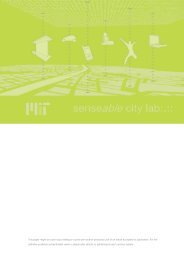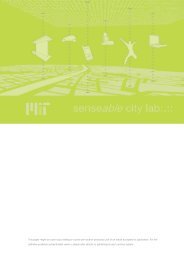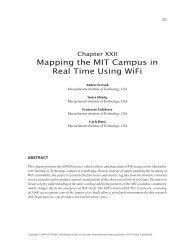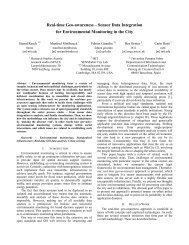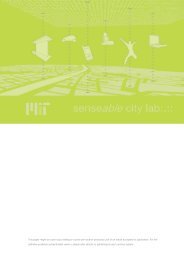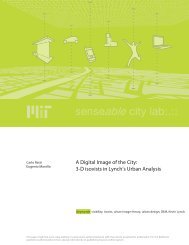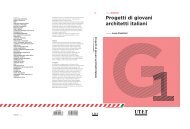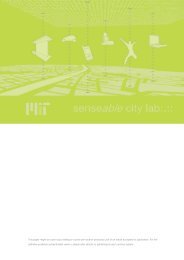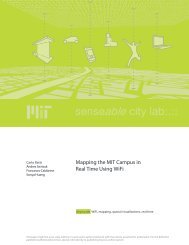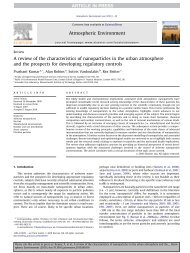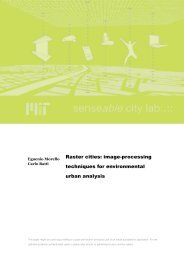Embedded Sensing for Standardised Urban Environmental Monitoring
Embedded Sensing for Standardised Urban Environmental Monitoring
Embedded Sensing for Standardised Urban Environmental Monitoring
Create successful ePaper yourself
Turn your PDF publications into a flip-book with our unique Google optimized e-Paper software.
III.CHALLENGES OF URBAN ENVIRONMENTALMONITORING AND SENSINGThe urban context poses many challenges toenvironmental monitoring: not only are there significanttechnical and technological issues, but also social andpolitical ones as well.The key technological challenge is the integration ofdifferent data sources owned by governmental institutions,public bodies, energy providers and private sensor networkoperators. This problem can be tackled with self-containedand well-conceived data encapsulation standards –independent of specific applications – and en<strong>for</strong>ced by legalentities, as discussed in chapter IV. However, the adaptationof existing sensors to new standards is costly <strong>for</strong> data ownersand network operators in the short term, and so increasedawareness of the benefits of open standards is required.From a technical viewpoint, unresolved researchchallenges <strong>for</strong> ubiquitous urban monitoring infrastructuresare manifold and include: finding a uni<strong>for</strong>m representationmethod <strong>for</strong> measurement values, optimising data routingalgorithms in multi-hop networks, and developing optimaldata visualisation and presentation methods. The last is anessential aspect of decision support systems, as different usergroups might need different views of the underlyingin<strong>for</strong>mation. For example, in emergency local authoritiesmight want a socio-economic picture of the affected areas,while first-response <strong>for</strong>ces are interested in topography andpeople’s current locations, and the public might want generalin<strong>for</strong>mation about the predicted development of a disaster.From a more contextual standpoint, an importantpeculiarity of the urban context is that there are largevariations within continuous physical phenomena over smallspatial and temporal scales. For instance, due totopographical, physical or optical irregularities, pollutantconcentration can differ considerably, even on opposite sidesof the street. This variability tends to make individual pointmeasurements less likely to be representative of the systemas a whole. The consequence of this dilemma is an evolvingargument <strong>for</strong> environmental regulations based oncomprehensive monitoring data rather than mathematicalmodelling, and this demand is likely to grow. Consequently,the deployment of many sensors allows <strong>for</strong> morerepresentative results together with an understanding oftemporal and spatial variability.One way to overcome this issue is to „sense people” andtheir immediate surroundings using everyday devices such asmobile phones or cameras. These can replace – or at leastcomplement – the extensive deployment of specialised citywidesensor networks. The basic trade-off of this peoplecentricapproach is between cost efficiency and real-timefidelity. We believe that the idea of using existing devices tosense the city is crucial, but that it requires more research onsensing accuracy, data accessibility and privacy, locationprecision, and interoperability in terms of data and exchange<strong>for</strong>mats. Furthermore, measurements are only available in aquasi-continuous distribution due to the high spatial andtemporal variability of ad-hoc data collection. Addressingthis issue will require complex distribution models andefficient resource discovery mechanisms in order to ensureadaptability to rapidly changing conditions.Another central issue in deploying sensor networks in thecity is the impact of fine-grained urban monitoring, as termslike „air quality” or „pollutant dispersion” are only asurrogate <strong>for</strong> a much wider and more direct influence onpeople, such as life expectation, respiratory diseases orquality of life. This raises the demand of finding the rightlevel of in<strong>for</strong>mation provision. More accurate, finer-grainedor more complete in<strong>for</strong>mation might in many cases notnecessarily be worthwhile having, as this could allow <strong>for</strong>drawing conclusions on a very small scale, in extreme caseseven on the individual. This again could entail a dramaticimpact in a very wide range of areas like health care, theinsurance sector, housing markets or urban planning andmanagement.Finally, some more unpredictable challenges posed bythe dynamic and volatile physical environment in the city areradical weather conditions, malfunctioning hardware,connectivity, or even theft and vandalism.IV.POLICY-FRAMEWORKS FOR THE INTEGRATION OFREAL-TIME SENSOR INFORMATIONAs mentioned above, we have seen an explosion ofspatial data collection and availability in digital <strong>for</strong>m in thepast several years. There are various national andinternational ef<strong>for</strong>ts to establish spatial data infrastructures(SDI) <strong>for</strong> promoting and sharing geospatial in<strong>for</strong>mationthroughout governments, public and private organisationsand the academic community. It is a substantial challengesolving the political, technological and semantic issues <strong>for</strong>sharing geographic in<strong>for</strong>mation to support decision makingin an increasingly environment-oriented world. In 2007, theUnited Nations Geographic In<strong>for</strong>mation Working Grouppublished a report subsuming recent regional national andinternational technologies, policies, criteria, standards andpeople necessary to organise and share geographicin<strong>for</strong>mation. These include real-time location aware sensormeasurements to develop a United Nations Spatial DataInfrastructure (UNSDI) and encourage interoperabilityacross jurisdictions and between UN member states. Asdescribed, these SDIs should help stimulate the sharing andre-use of expensive geographic in<strong>for</strong>mation in several ways:• The Global Spatial Data Infrastructure Associationis one of the first organisations to promoteinternational cooperation in developing andestablishing local, national and international SDIsthrough interaction between organisations andtechnologies supported by the U.S. GeologicalSurvey (USGS).• On a supra-national level, the INfrastructure <strong>for</strong>SPatial In<strong>for</strong>mation in Europe (INSPIRE) aims toenable the discovery and usage of data <strong>for</strong> analysingand solving environmental problems by overcomingkey barriers such as inconsistency in data collection,a lack of documentation, and incompatibilitybetween legal and geographic in<strong>for</strong>mation systems.




